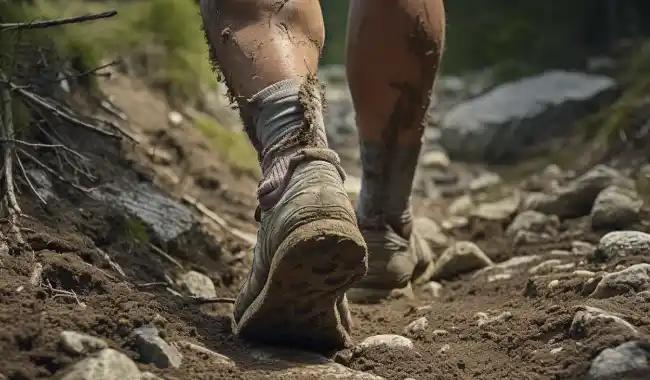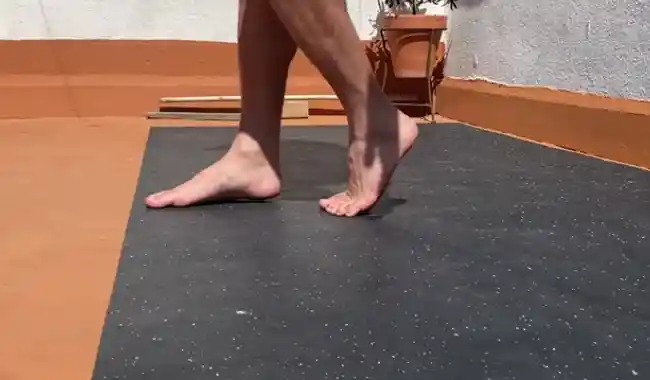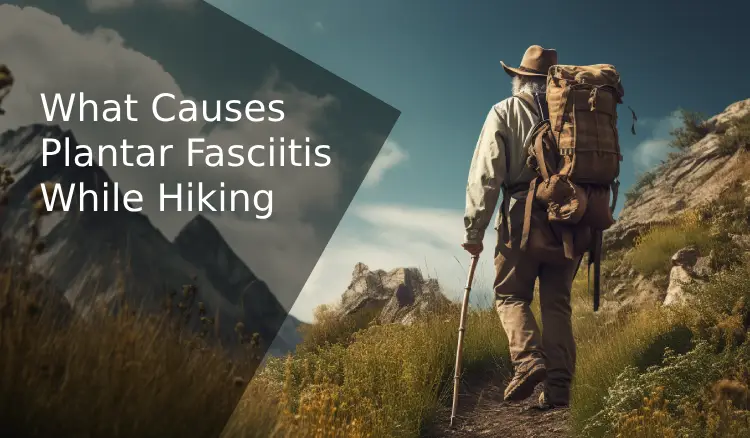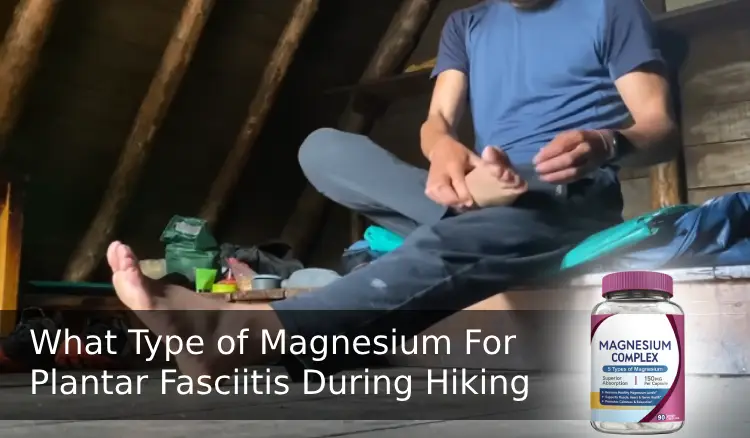Do you love hiking but hate the foot pain that comes with it? Well, you’re not alone. Plantar fasciitis, a common condition among hikers, can put a damper on your outdoor adventures. But actually what causes plantar fasciitis while hiking?
To begin with, repetitive strain on the feet and heels can lead to inflammation and pain in the plantar fascia. Plantar fasciitis can also be caused by faulty biomechanics, such as overpronation or supination.
And, tight calf muscles, inadequate foot support, and insufficient foot conditioning can all play a role in the onset of this condition.
Throughout this article, we’ll discuss the causes of plantar fasciitis while hiking and provide you with expert tips on how to prevent it.
What Causes Plantar Fasciitis While Hiking: Real Reasons

There are several key points to consider to understand what causes plantar fasciitis while hiking. Here are some of the most common causes:
- Repetitive strain
- Faulty biomechanics
- Tight calf muscles
- Inadequate foot support
- Insufficient foot conditioning
- Overloading backpack
- A sudden increase in intensity
- Inadequate warm-up
- Poor terrain choice
Now look at each of these causes in more detail.
No 01: Repetitive Strain
Hiking for extended periods can strain the plantar fascia, causing inflammation and pain. When you hike on uneven terrain, your feet constantly adapt to the changing surfaces, resulting in repetitive stress on the plantar fascia. This repetitive strain can lead to micro-tears in the tissue, causing inflammation and pain.
The plantar fascia, a thick band of tissue that runs along the bottom of your foot, acts as a shock absorber and supports the arch of your foot. However, when it is subjected to excessive strain, it becomes irritated and inflamed.
No 02: Faulty Biomechanics
Faulty biomechanics, such as overpronation, can increase the risk of developing plantar fasciitis while hiking.
Overpronation occurs when the foot rolls excessively inward, putting extra strain on the plantar fascia. This may cause inflammation and pain in the arch of the foot.
No 03: Tight Calf Muscles
Tight calf muscles can contribute to inflammation and pain in the arch of your foot. When your calf muscles are tight, they can tug on the Achilles tendon, affecting the tension on the plantar fascia. This increased tension can lead to an increased risk of foot pain and inflammation, a condition known as plantar fasciitis.
No 04: Inadequate Foot Support
Wearing shoes without proper arch support can strain your foot and increase the risk of pain and inflammation in your arch. When feet tissue becomes strained, plantar fasciitis can develop, a common condition characterized by heel pain and inflammation.
No 05: Insufficient Foot Conditioning
When you don’t properly condition your feet before a challenging hike, it can lead to sudden stress on the plantar fascia and result in pain. Insufficient foot conditioning is a common cause of plantar fasciitis while hiking.
No 06: Overloading Backpack
Carrying a heavy backpack can significantly impact your foot’s ability to absorb shock and increase strain on the plantar fascia.
When you overload your backpack with excessive weight, your feet have to work harder to maintain balance and stability. This can lead to an altered gait and improper distribution of weight, putting extra pressure on the plantar fascia.
No 07: Sudden Increase in Intensity
Increasing the intensity of hikes quickly with proper progression can strain and inflame the plantar fascia. When you suddenly increase the intensity of your hikes by tackling steeper terrains or longer distances, you put excessive stress on the plantar fascia. This can lead to microtears and inflammation in the tissue, causing plantar fasciitis.
No 08: Inadequate Warm-up
Skipping warm-up exercises before hiking can lead to cold, tight muscles more prone to strain and injury. When you embark on a hike without properly warming up, your muscles need to prepare for the physical demands of the activity.
As a result, they become tight and less flexible, making them susceptible to strain and injury, including plantar fasciitis.
No 09: Poor Terrain Choice
When you choose rugged or uneven terrains for hiking, your feet are subjected to excessive stress and strain, which can lead to pain and inflammation in the plantar fascia. Poor terrain choice is one of the common causes of plantar fasciitis while hiking.
The uneven surfaces can put uneven pressure on your feet, causing the plantar fascia to stretch and strain beyond its normal limits. Steep inclines or descents can also increase the impact and force on your feet, further exacerbating the risk of developing plantar fasciitis.
How Do You Prevent Plantar Fasciitis When Hiking?
Now you know the common causes of plantar fasciitis when hiking, what can you do to reduce the risk? Here are some tips:
Proper Footwear Selection

For preventing plantar fasciitis while hiking, proper footwear selection is crucial.
Your shoes should provide excellent arch support and cushioning to alleviate stress on your feet. Look for hiking shoes or boots that have a supportive midsole and a contoured insole that molds to the shape of your foot.
Also, consider the terrain you’ll be hiking on. If you’ll be tackling rocky or uneven trails, opt for shoes with a sturdy outsole that offers good traction.
Remember to try on different styles and brands to find the perfect fit for your foot type. Investing in the right hiking shoes or boots will greatly reduce your risk of developing plantar fasciitis and ensure a more enjoyable hiking experience.
Gradual Progression
Take your time and gradually increase the distance and intensity of your hikes to allow your feet to adjust and avoid overexertion.
It’s important to gradually build up your endurance and strength during hiking. By starting with shorter distances and easier terrains, you allow your feet to adapt to the demands of hiking. This gradual progression allows your muscles, tendons, and ligaments to become stronger and more resilient, reducing the risk of developing plantar fasciitis.
Pushing yourself too hard or too quickly can strain your feet excessively, leading to inflammation and injury. Remember to listen to your body and take breaks when needed.
Slowly increasing your hiking distance and intensity will help prevent plantar fasciitis and ensure an enjoyable hiking experience.
Pre-hike Warm-up
Engaging in dynamic warm-up exercises and stretches specifically targeting your calf muscles and plantar fascia can significantly prevent injury. These exercises increase blood flow, improve flexibility, and prepare your muscles for the physical demands of hiking.
You can relieve plantar fasciitis by stretching your toes, raising your calf and rotating your ankles. Additionally, performing stretches that target the calf muscles and the plantar fascia itself can help alleviate tension and minimize the risk of developing plantar fasciitis.
Stretching Routine
To maintain flexibility and prevent injury, be sure to incorporate regular stretching of your calf muscles, Achilles tendon, and plantar fascia into your daily routine.
Stretching these muscles and tendons can help improve their flexibility, reduce muscle tightness, and increase blood flow to the area.
Start by standing facing a wall with your hands on the wall at shoulder height. Step one foot back and keep it straight while bending the front knee. Lean forward, keeping your back heel down until you feel a stretch in your calf. Hold for 30 seconds and repeat on the other side.
For the Achilles tendon, stand facing a wall and place one foot behind the other. Lean forward, keeping both heels on the ground until you feel a stretch in your Achilles.
Weight Management
Maintaining a healthy weight can reduce strain on your feet and contribute to the prevention of plantar fasciitis. Excess weight puts extra pressure on your feet, leading to plantar fasciitis and pain. The ligament that connects your heel to your toes.
By managing your weight, you can alleviate the burden on your feet and lower the risk of developing this condition while hiking. Adopt a healthy diet that’s full of fruit, veggies, lean proteins, and whole grains.
Incorporating regular exercise into your routine can also help you maintain a healthy weight and strengthen the muscles in your feet, reducing the likelihood of plantar fasciitis.
Proper Technique
Using trekking poles can help with weight distribution and stability while hiking, reducing strain on the feet. When hiking, it is important to have proper techniques to prevent plantar fasciitis.
One key aspect of proper technique is to ensure that your foot strikes the ground in a neutral position, neither pronating or supinating excessively. This can be achieved by maintaining a strong core and engaging your glutes and hamstrings while walking.
Additionally, taking shorter strides and maintaining a steady pace is crucial to avoid putting excessive pressure on the plantar fascia.
When walking uphill, lean slightly forward and use your trekking poles to push off and propel yourself forward. When descending, control your speed by using your poles to provide stability and support.
Supportive Insoles
Consider trying supportive insoles or custom orthotics to alleviate discomfort and improve foot alignment while hiking. Supportive insoles are designed to provide additional cushioning and arch support, which can help reduce strain on the plantar fascia and prevent overpronation.
Overpronation, or excessive inward rolling of the foot, is a common cause of plantar fasciitis. Providing proper foot alignment, supportive insoles can help distribute your weight evenly across your feet, reducing pressure on the plantar fascia and decreasing the chances of plantar fasciitis while hiking.
On the other hand, custom orthotics are specifically tailored to your foot shape and can provide even more personalized support. Whether you choose supportive insoles or custom orthotics, it is important to ensure they fit properly and are suitable for your specific foot type and hiking needs.
Who is most likely to get plantar fasciitis?
If you enjoy hiking, it’s important to be aware of the risk factors that can contribute to the development of plantar fasciitis.
While anyone can experience this condition, certain individuals may be more susceptible. Men between the ages of 40 and 70 who engage in active lifestyles are more likely to develop plantar fasciitis.
Those with foot arch problems, such as flat feet or high arches, are also at a higher risk. Furthermore, if you regularly engage in long-distance running or hike on uneven surfaces, you may increase your likelihood of developing plantar fasciitis.
Understanding these risk factors can help you take preventative measures and avoid accidents while hiking.
Can I get rid of plantar fasciitis forever?

You can definitely get rid of plantar fasciitis forever with proper treatment and care.
It is important to understand that plantar fasciitis is a condition that is typically responsive to treatment, and most people can fully recover within a few months.
The key to long-term relief is following a comprehensive treatment plan that includes stretching exercises, physical therapy, and orthotic devices.
Giving your feet adequate rest and avoiding activities that exacerbate the pain is also important. Additionally, wearing supportive footwear and arch supports can help alleviate the pressure on the plantar fascia.
Stop Suffering from Plantar Fasciitis While Hiking
You now know what causes plantar fasciitis while hiking and how to prevent it. Most causes are preventable and can be managed with proper care and treatment.
You can reduce your risk of developing this painful condition by making sure you have proper footwear, gradually increasing your hiking intensity, warming up before each hike, using proper technique, and using supportive insoles.
Remember, anyone can get plantar fasciitis, but by taking these precautions, you can enjoy your hikes without worrying about discomfort. Keep exploring and happy hiking.




Leave a Reply